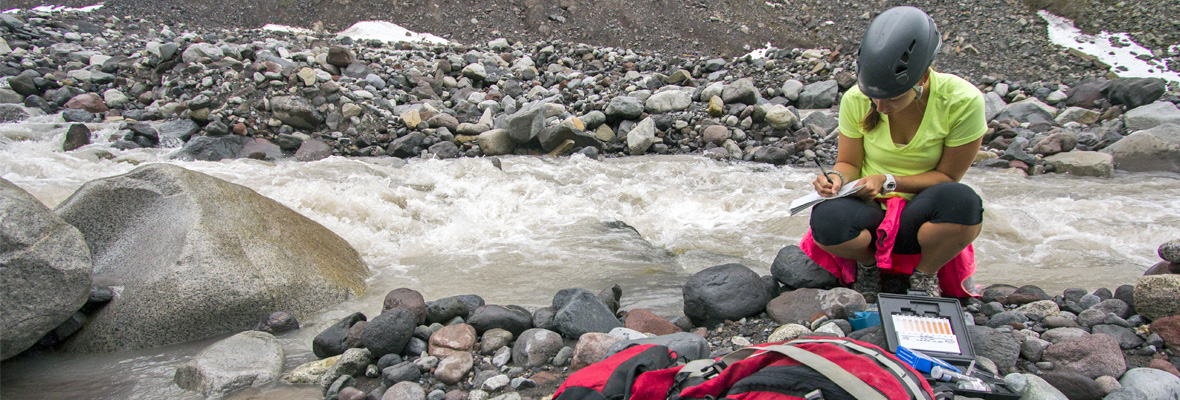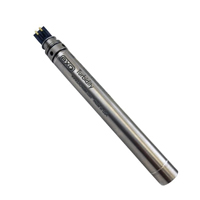In this post, we’ll continue the discussion about understanding water quality parameters, cover why each is important, and understand how these parameters vary naturally and can affect water quality.
pH
Like temperature, pH is based on a defined scale, a determined value. This means that water pH is not a measurable physical parameter as a quantity or concentration. Rather, it falls along a logarithmic scale defining how basic or acidic a body of water is—a figure between 0 and 14. Each number is 10 times more or less acidic than the last in the sequence. A higher number is more basic, and vice versa, while 7 is a neutral pH.
The quantitative ability of water or a solution to neutralize an acid is its alkalinity or acid-neutralizing capacity (ANC). Alkalinity measures the capacity of water to withstand changes in pH. Although pH and alkalinity are closely related, they are distinct due to various factors that influence alkalinity, such as acid rain, air saturation, the presence of sewage outflow and other pollution, and the presence of carbonate-rich soils such as limestone.
There is a close connection between daily pH levels and the alkalinity of water. Algae and plants use hydrogen during photosynthesis, causing pH levels to rise. Likewise, respiration and decomposition can lower pH levels. Localized, smaller variations change quickly and can be tough to detect, because bodies of water can often absorb them due to their alkalinity.
It is critical to monitor pH because it can affect the toxicity and solubility of heavy metals and chemicals in water. Aquatic creatures will also die in water with pH that is too low or too high. In fact, most aquatic organisms prefer a pH in the neighborhood of 6.5 and 9.0, although some creatures can survive in water with more extreme pH levels.
For more on the pH of water, read the Fondriest guide here.
Temperature
Temperature is the physical measure of how cold or hot water is. Water temperature is most important as it relates to a host of other factors that influence water quality, although it does have its own effects, as well.
There is a relationship between water temperature and biological activity in both aquatic plants and animals. Temperature changes can affect the metabolic rates as well as the behavioral choices of aquatic organisms. Temperature also affects photosynthesis and plant respiration, with different species having different optimal temperature ranges for photosynthetic activity.
Compound toxicity in water is related to its temperature. As water temperature rises, solubility of certain elements and compounds such as ammonia and heavy metals cadmium, lead, and zinc increases—and with solubility, toxicity. Higher water temperatures can also reduce an organism’s tolerance limit as metabolic rate, tissue permeability, and oxygen consumption, which all rise with water temperature.
Dissolved oxygen (DO) and other concentrations of dissolved gases. As water temperature rises, the solubility of oxygen and other gases drops. This means that rivers, streams, and lakes with cooler water can hold more DO. Aquatic organisms cannot survive in water temperatures that are too high.
There are two ways that water temperature can affect conductivity. First, as water temperature increases, so does conductivity: approximately 5% for every 1°C increase in temperature in pure water, and otherwise about 2 to 3% for every 1°C. Temperature can also impact conductivity through ionic concentration because at higher temperatures, many salts are more soluble. The higher levels of ions and dissolved minerals in warmer waters can mean greater numbers of ion particles, in solution, that are smaller than 2 microns—or total dissolved solids (TDS). Conductivity increases with ionic concentration.
Water density and temperature are directly connected, and the density of frozen water decreases by about 9%. This enables ice to expand and float on water.
Many ambient conditions can affect water temperature, including heat transfer from the atmosphere, stream confluence, sunlight/solar radiation, and turbidity. Deep water is less affected by these factors than are surface and shallow waters. Usual or expected temperatures depend on the type of body of water, it’s depth, the season, the water body’s latitude, and the environment surrounding the water.
Both overly warm and overly cool water temperatures are potentially dangerous for aquatic life, affecting disease tolerance, growth, and survival rate, although in general warm water carries greater risk with it. Overly cold water will slow the metabolic rates and biological processes of aquatic organisms, while excessively warm water can stress fish with respiration rates that are too taxing. Cold water also holds more dissolved oxygen than does warm water, so more oxygen is available for uptake by aquatic life in cooler waters. In all, a failure to monitor water temperature is a basic failure in the realm of understanding water quality parameters.
For more on water temperature, refer to our guide.
Turbidity
Turbidity is an optical water quality parameter that refers to water clarity and affects the way water physically looks. Turbid water appears colored, murky, hazy, or otherwise cloudy, thanks to suspended dissolved colored material and other solids that create a muddy look, reducing water clarity.
The turbidity of water in the column is based on how much light particles in the water scatter. In general, more particles mean more scattering of light, and as such, total suspended solids (TSS) and turbidity are related. However, a direct measurement of TSS and turbidity are not the same. In contrast, turbidity is often used as a measure of relative clarity to reveal changes in TSS concentration without measuring solids precisely.
Inorganic materials, organic matter such as decaying matter, plankton, and algae, and suspended sediment such as clay or silt can all contribute to turbidity. Turbidity might also include fluorescent dissolved organic matter (FDOM), colored dissolved organic matter (CDOM), and other dyes.
The most visible water quality indicators, turbidity and TSS might arise from algal blooms, bottom sediments being stirred up, discharges, runoff, or soil erosion. Some rivers and streams may have naturally high TSS levels, but clearer water is usually more likely to be healthier, and a sudden increase in turbidity is a warning sign. Excessive solids can impede navigation, impair water quality for human and aquatic life, and increase risk of floods.
Conclusion
Understanding water quality parameters and monitoring them allows researchers to learn from natural process and predict how human actions will impact the environment. Understanding how water quality parameters work and are measured also lends support to regulators working to establish and maintain healthy environmental standards and restoration projects along the same lines.
For more detailed guides on every aspect of water quality, start with our water quality hub.
Equipment
The EXO unguarded pH sensor is a digital smart sensor featuring welded titanium construction and wet-mateable connectors.
The EXO wiped conductivity & temperature sensor is designed for the EXO2 sonde with central wiper to reduce cleaning requirements in unattended deployments.
The EXO turbidity sensor is a digital smart sensor featuring welded titanium construction and wet-mateable connectors.
Top image: Mount Rainier National Park from Ashford, WA, United States [CC BY 2.0]





0 comments